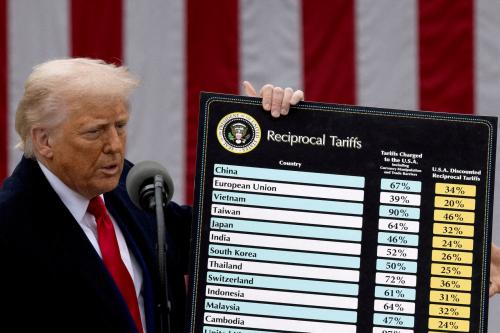Four years ago, President Obama’s bold challenge in his 2010 State of the Union address—to double U.S. exports by the end of 2014—sparked the needed culture shift away from domestic consumption, which was in a slump.
Yet, despite demonstrable success in job creation and business growth, there are indications the president may sidestep the importance of trade in this year’s State of the Union address, yielding to anti-trade voices and Congressional Democrats who say, playing upon growing concerns about inequality and social mobility, that trade policies and globalization are bad for workers.
That would be a mistake.
The United States is making tangible strides in creating export-oriented growth and more jobs in the traded sectors, which are essential to closing the jobs deficit and creating quality opportunities for workers.
Fudging on trade will also send the wrong signal to business, civic, and political leaders in metro areas across the country who are on the frontlines of delivering that job growth. Many are striving to get past the real estate- and domestically-induced economic growth of the previous decade, looking globally for new markets and investments. And they must. Two-thirds of the nation’s 100 largest metro areas have their own jobs deficits to close.
Rather than succumb to the critiques of globalization, the president must affirm that bottom-up exports growth is the right direction for the country and can be a platform for job growth and opportunity for workers.
The national export challenge articulated in 2010 raised new awareness among firms about growth opportunities outside the United States. Now a record 302,000 firms are selling products abroad, up from 276,000 in 2009.
It helped spur the creation of a number of export plans in states and metro areas, with many regional economic development groups changing their activities for the first time to prioritize helping their member firms find new customers abroad and expand job opportunities at home.
Portland’s plan to double their exports, and diversify beyond computer and electronics exports, resulted in a winning contract for a mix of sustainable development firms to help Japan build a “green city.” In the Bluegrass region, Louisville Mayor Greg Fischer and Lexington Mayor Jim Gray have issued a goal to double the number of firms that export, an effort which received an additional boost from a new grant program for businesses. Chicago, led by Mayor Rahm Emanuel and World Business Chicago, has forged a new “trade pact” with Mexico City to jointly boost exports, foreign direct investment, and innovation in their shared industries.
Since 2009 U.S. exports have surged, aided by increased domestic energy production and continued demand from markets within Europe, Mexico, and China. U.S. exports reached a record $194.9 billion last November. The trade gap narrowed to its smallest level since 2009. Exports now make up 13.2 percent of U.S. economic output, up from 10.7 percent in 2009. Metro areas like Detroit, Cleveland, Kansas City, and Las Vegas experienced net economic output over the past three years solely due to exports.
The growth in exports has been good for workers. Every $1 billion in new exports creates 4,900 new jobs and supports thousands of indirect jobs within the supply chain and the shipping and logistics sector. These jobs also pay better. Andrew Bernard and Bradford Jensen found that workers in exporting manufacturing firms in the 1980s took home higher weekly earnings than those in non-exporting firms. Today, that premium has widened for workers in both export-intensive manufacturing and services industries.
What’s harder to measure is how jobs were saved as a result of international demand. Some small- and mid-sized exporting manufacturers cite that if it had not been for growth in international sales since the recession (which generated net revenue growth for exporting smaller businesses and revenue loss for non-exporters), they would have had to lay off U.S. workers. Executives in Pelican Products, a Los Angeles area manufacturer of high-performance storage cases, told a Brookings-organized delegation that revenues from their global sales division have enabled the company to retain and invest in skills training for its highly diverse and long-time California-based workforce.
These concrete results and actions should spur Obama to reiterate his commitment to the National Export Initiative, which expires this year, and to the firms and communities making it real. He should empower SelectUSA, the nation’s new investment promotion agency, to effectively partner with states and regions to create job training programs and investable opportunities for foreign firms locating in the United States. He needs to continue to invest in innovation so industries can produce highly differentiated quality products and services for global customers. He needs to push through his commitment to career and technical education and training so workers are armed with the skills to participate in the industries of the future.
With inequality on the rise, the president’s likely skittishness about global trade is understandable. The globally integrated economy (not simply trade policy) has created winners and losers, one that has favored high productivity firms, skilled workers, and innovative regions over less productive ones. But global trade has also expanded the global middle class in nations that have embraced trade. They now represent a substantial source of new customers for American-made goods and services and an opportunity for the president and working Americans.
The Brookings Institution is committed to quality, independence, and impact.
We are supported by a diverse array of funders. In line with our values and policies, each Brookings publication represents the sole views of its author(s).



Commentary
Mr. President, Don’t Back Down on Trade in the State of the Union
January 27, 2014